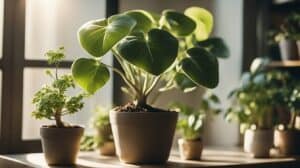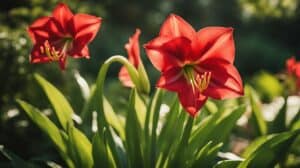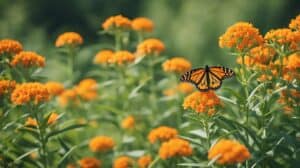Fittonia Albivenis Fascination is a stunning houseplant that is known for its vibrant foliage.
This plant is commonly known as the nerve plant due to its intricate veining patterns on its leaves.
The plant is native to the tropical rainforests of South America and requires specific care to thrive indoors.

The Fittonia Albivenis Fascination is a popular choice among plant enthusiasts due to its unique appearance and low maintenance requirements.
However, caring for this plant can be a challenge, especially for beginners. In this article, we will explore the secrets to vibrant nerve plant care.
From lighting and watering to soil and fertilizer, readers will learn everything they need to know to keep their Fittonia Albivenis Fascination healthy and beautiful.
Understanding Fittonia Albivenis
Species Overview
Fittonia Albivenis, commonly known as Nerve Plant, is a popular houseplant that belongs to the Acanthaceae family.
This plant is native to the tropical rainforests of South America, specifically Peru, where it grows as an understory plant.
Nerve Plant is characterized by its delicate, veined leaves that come in a variety of colors, including green, pink, and white.
Common Names and Varieties
The Nerve Plant is also known by other common names, such as Mosaic Plant, Silver Nerve Plant, and Painted Net Leaf.
There are several varieties of Fittonia Albivenis, including the popular Fascination variety, which has green leaves with pink veins.
Other varieties include White Anne, Pink Angel, and Red Anne.
Natural Habitat and History
As mentioned earlier, Fittonia Albivenis is native to the tropical rainforests of South America, where it grows in the understory of the forest floor.
In its natural habitat, the plant is accustomed to low light levels, high humidity, and warm temperatures.
The plant was first discovered in 1867 by a German botanist named Karl von Scherzer, who named it after his colleague, Sarah Ann Fitton.
Overall, Fittonia Albivenis is a beautiful and fascinating plant that can add a touch of color and vibrancy to any indoor space.
With the right care and attention, this plant can thrive and bring joy to its owner for years to come.
Essential Care Guidelines

Lighting Requirements
Fittonia Albivenis Fascination requires bright, indirect light to thrive. Direct sunlight can scorch the leaves and cause damage.
If the plant is not receiving enough light, the leaves will start to droop and lose their vibrant color.
It is best to place the plant near a window that receives bright, indirect light.
If the plant is receiving too much light, it can be moved to a spot with slightly less light.
Watering Techniques
It is important to keep the soil of Fittonia Albivenis Fascination consistently moist. However, overwatering can lead to root rot and damage the plant.
It is recommended to water the plant when the top layer of soil feels dry to the touch.
It is also helpful to use a pot with drainage holes to prevent water from accumulating at the bottom of the pot.
Soil and Repotting
Fittonia Albivenis Fascination prefers well-draining soil that is rich in organic matter. A mix of peat moss, perlite, and vermiculite is ideal.
The plant should be repotted every 1-2 years to prevent the roots from becoming too crowded.
When repotting, it is important to use a pot that is slightly larger than the current one to allow for growth.
Temperature and Humidity Control
Fittonia Albivenis Fascination thrives in warm, humid environments.
It is best to keep the plant in a room with a temperature between 60-80°F (15-27°C) and a humidity level of 50-70%.
If the air in the room is too dry, the plant can be misted with water or placed on a tray of pebbles and water to increase humidity.
By following these essential care guidelines, your Fittonia Albivenis Fascination will thrive and display its vibrant colors for years to come.
Propagation and Growth Tips

Propagation Methods
Fittonia Albivenis Fascination is a plant that can be propagated through stem cuttings.
The best time to propagate is during the spring or summer months when the plant is actively growing.
To propagate, take a stem cutting that is about 4-6 inches long and remove the leaves from the bottom 2 inches of the stem.
Dip the cut end of the stem in rooting hormone and plant it in a pot filled with a well-draining potting mix.
Keep the soil moist and place the pot in a location with bright, indirect light.
After a few weeks, the cutting should begin to root and new growth should appear.
Growth Patterns and Pruning
Fittonia Albivenis Fascination is a slow-growing plant that typically reaches a height of 6-12 inches. It prefers bright, indirect light and moist soil.
Overwatering can lead to root rot, so it’s important to water only when the top inch of soil feels dry.
Fertilize the plant every 2-3 months with a balanced fertilizer.
To promote bushier growth, pinch back the tips of the stems regularly.
This will encourage the plant to produce more lateral shoots and create a fuller appearance.
If the plant becomes leggy or overgrown, it can be pruned back by cutting the stems back to just above a leaf node.
This will encourage new growth and help maintain the plant’s shape.
Overall, Fittonia Albivenis Fascination is a relatively low-maintenance plant that can be propagated easily and kept looking vibrant with a few simple care tips.
Troubleshooting Common Issues

Pest Prevention and Management
Fittonia Albivenis Fascination is susceptible to pest infestations, which can cause significant damage to the plant.
Common pests that may affect the plant include spider mites, mealybugs, and scale insects.
To prevent pest infestations, it is essential to keep the plant healthy and clean.
Regularly inspect the plant for signs of pests, such as webs, sticky residue, or tiny insects.
If pests are present, isolate the plant and treat it with a suitable insecticide.
Disease Identification and Treatment
Nerve plants are prone to fungal and bacterial infections, which can cause leaf spots, wilting, and stunted growth.
To prevent disease, avoid overwatering the plant and ensure proper drainage.
If the plant shows signs of disease, remove the affected leaves and isolate the plant to prevent further spread.
Treat the plant with a suitable fungicide or bactericide according to the instructions on the label.
Addressing Yellowing Leaves and Wilting
Yellowing leaves and wilting are common problems that may indicate overwatering, underwatering, or poor soil quality.
To address these issues, check the soil moisture level and adjust the watering frequency accordingly.
Ensure that the plant is not exposed to direct sunlight or drafts, which can cause stress and damage to the plant.
If the soil quality is poor, repot the plant in a well-draining soil mix and fertilize it with a balanced fertilizer.
Overall, maintaining a healthy and vibrant Fittonia Albivenis Fascination requires regular care and attention.
By following these tips and troubleshooting common issues, you can ensure that your plant thrives and adds beauty to your indoor space.
Frequently Asked Questions

What are the ideal lighting conditions for a Fittonia albivenis?
Fittonia albivenis plants prefer bright, indirect light.
Direct sunlight can scorch their leaves, while insufficient light can cause them to lose their vibrant colors.
A north-facing window or a spot near an east or west-facing window with a sheer curtain can provide the ideal lighting conditions.
How often should I water my nerve plant to keep it healthy?
Fittonia plants prefer consistently moist soil, but not waterlogged. It’s best to water them when the top inch of soil feels dry to the touch.
Overwatering can lead to root rot, while underwatering can cause the plant to wilt and dry out.
It’s important to maintain a balance and not let the soil completely dry out between watering sessions.
Can you provide tips for propagating a pink nerve plant?
Propagation of Fittonia albivenis plants can be done through stem cuttings. Take a healthy stem cutting with a few leaves and place it in a glass of water.
Ensure that the cutting receives bright, indirect light and change the water every few days.
Once roots develop, transfer the cutting to a pot with well-draining soil.
What is the best way to encourage a bushy growth in my Fittonia?
Pinching off the tips of the stems can encourage bushy growth in Fittonia plants.
This can be done by using clean scissors to snip off the top few inches of the stem.
This will encourage the plant to grow more lateral branches and create a fuller, bushier appearance.
Are there any common pests or diseases to watch out for with Fittonia plants?
Mealybugs and spider mites are common pests that can infest Fittonia plants.
Regularly inspecting the plant for signs of infestation and treating it with insecticidal soap or neem oil can help prevent and control these pests.
Overwatering can also lead to root rot, so it’s important to ensure that the soil is well-draining.
How can I tell if my nerve plant is getting too much or too little humidity?
Fittonia plants prefer a humid environment, but too much or too little humidity can cause problems.
Signs of too much humidity include yellowing leaves, while signs of too little humidity include brown, crispy leaf edges.
A humidifier or pebble tray can help maintain the ideal humidity level for the plant.














